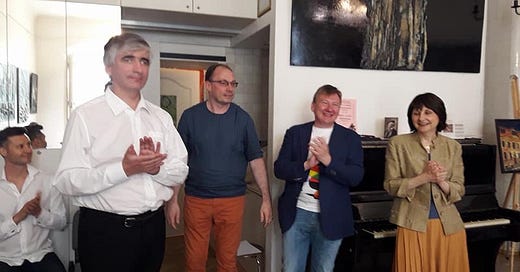I am shocked by the news of the death of Raivis Zabis, well known collector and promoter of contemporary art, who passed away at the age of 50.
It was a privilege for me to work with Raivis on a cultural project “Richard Wagner in Riga” in 2018, and to contribute to his art catalogue “The Ripple Effect of Art” a few months ago.
To commemorate Raivis, I wish to share with everyone the link to his last catalogue and my article “Inspired by Wagner”. RIP, Raivis!
Link to the catalogue: The Ripple Effect of Art. RZ collection.
On the photo (left to right): Anton Boldyrev, Raivis Zabis, Viacheslav Vlasov and Inna Udovichenko at the opening of “Richard Wagner in Riga” cultural project in Art-refuge Alberts Gallery in Riga in 2018
Inspired by Wagner
For a quarter of a century, my life has been inextricably linked to the work of the great composer Richard Wagner. I was in my early twenties the first time I ever heard his mystery Parsifal. I have been trying for a long time to find an epithet for my feelings: the music simply struck me - this will be, probably, the most accurate one. I was also struck by the fact how close it was to me: music had captivated me completely and did not let me go, made my brain search for the reasons of its fantastic appeal and power, and reflect on its philosophical significance. Listening to this music gives me the feeling of eternity.
As my knowledge of Wagner's masterpieces increased, my desire to understand why he chose a particular plot for a particular opera and what exactly he sought to express with them also grew. I began to share my thoughts with friends in short notes about opera performances, and as soon as I met like-minded people among the creative community my inspiration began to take on more substantial form, grow and develop.
The artist Victor Vasilyev is undoubtedly one of the brightest interpreters of the Wagnerian heritage in the fine arts. I well remember my first impressions of Victor's paintings presented in 2017 at an exhibition in St. Petersburg. The paintings were not just the images of the heroes of Wagner’s operas that I knew well. They reflected the immersion in the world of their feelings and experiences: Erda’s concern for the fate of her daughter, the Valkyrie Brunnhilde, Waltraute’s sadness about the deplorable fate of her father, the supreme god Wotan, Brunnhilde’s happiness with the chance to save the world from the curse of the Nibelung’s ring, the unbridled passion of Tristan and Isolde. It was amazing: Victor depicted on canvas exactly the feelings that I wrote about in my notes! Two like-minded people could not help but get to know each other.
Since then, our strong "Wagnerian friendship", conversations and correspondence about Wagner's works have helped us with Victor Vasilyev to complement each other creatively. Over the past years, I have written stories about Wagner's life in Riga, St. Petersburg and Venice, and Victor has put these stories down onto canvas. Completing the set of canvases based on The Nibelung’s Ring and Parsifal, Victor explained his emotional bonds with Wagner's music as follows: “The specific feature of Wagner's music, in my opinion, is its emotionality, for all its severity. I visualize it in cold colors: blue, gray, black and certainly gold. Wagner’s music is congenial to me in terms of its’ sound of color”, if I can put it that way... My teacher, the St. Petersburg artist V. Lukka, describing my "palette" once said that mine was a "Baltic-German" one, and, as I understand , this unites me with Wagner, or he is close to me. We see and feel the world in the same way…”
The creative dialogue and the kindred spirit of the two artists inspired me to accompany each of Victor's works with a short text: "What would Wagner say about the paintings of Victor Vasilyev?" Our joint work has embodied in the Wagner Everywhere exhibition, presented to the St. Petersburg public and on the Internet in 2020.
I was delighted when the composer and pianist Anton Boldyrev who, along with such giants of pianism as Liszt, Tausig, von Bülow, has created his own paraphrases of Wagner's music joined us. “The idea of the paraphrase came to me after visiting Parsifal in 2002,”- says Anton. “The piano composer definitely ”vanished” inside Wagner, and I had to shorten the opera several times in order to create a 40-minute suite based on the opera’s leitmotivs. I worked with enthusiasm, so it was easy". As for the color sensation, a lot depends on the tone. The Scriabin palette is close to me. In other words, for me it is music with different shades of red. Like an orange-cap boletus!" Anton traditionally accompanies the public presentations of Victor's new works.
The interpretation of Wagner's masterpieces in color, and in relation not only to a specific operatic work, but also to "direct speech", to quotes from his heroes, stimulates interest not only in the composer's music, but also in the poetic texts of the libretto of his operas. So, the spectator naturally perceives the cultural synthesis of different types of art: music, painting, prose, and this is exactly what Richard Wagner was striving for.




